2006 VOLKSWAGEN GOLF child seat
[x] Cancel search: child seatPage 99 of 444
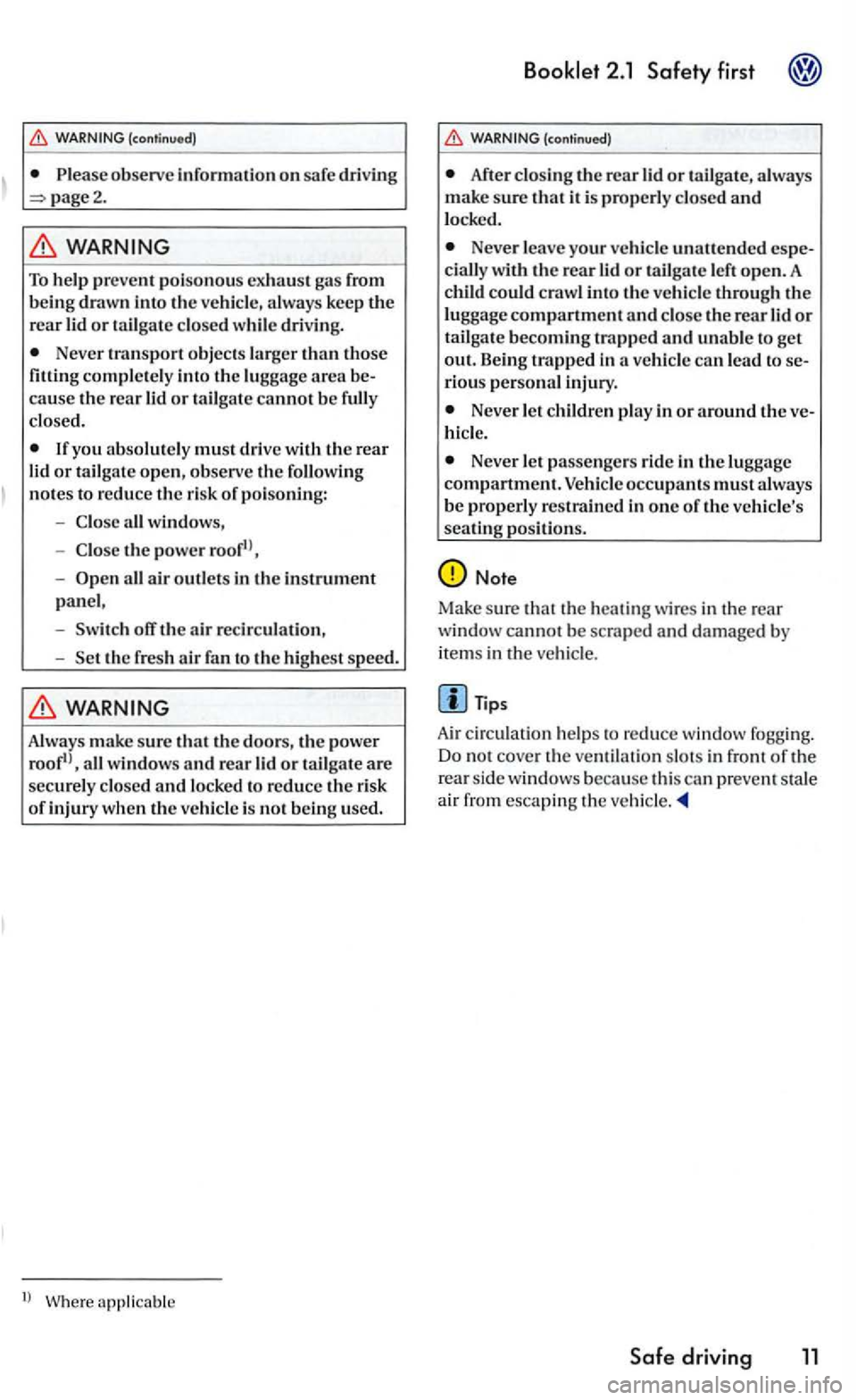
(continuod)
page2.
To hel p prevent p oisonous exhaust ga s from
b eing drawn into the ve hicle , a lways keep the
rear lid or t ailgat e closed w hil e driving.
Neve r transport o bjects la rger than those fitting comple tel y into th e luggage are a cause the rear lid or tailgate canno t b e full y
closed .
yo u absolute ly mus t drive with the rear
lid or t a ilgate ope n, o bserve the foll owing
n otes to reduce the r is k poisoning :
C lose w indows,
C lose th e power
air outl ets in the instrument p a n el,
off the air recirc ulation ,
Always make sure that the doors, the po w er
W here
Booklet 2.1 Safety first
Af te r closin g the rear lid o r tailgate, always make sur e tha t it is properl y closed an d locked.
Never leave your vehicle unattended
ri ous pe rson al injury.
Neve r let childre n play in o r around the hicl e.
Neve r let passengers ride in the luggage compartment. Vehicl e occupants must always
b e properl y res traine d in one of the ve hicle's seatin g position s.
Note
Make su re that the heating wires in the rea r
w indow cannot be scraped and damaged b y
ite ms in the ve hicle .
Air ci rc ulation he lp s to reduce wi ndow fogging. Do not cove r the ventilation slot s in front o f the rea r si de windows beca use this can prev ent sta le
a ir from escaping the
Safe driving 11
Page 100 of 444
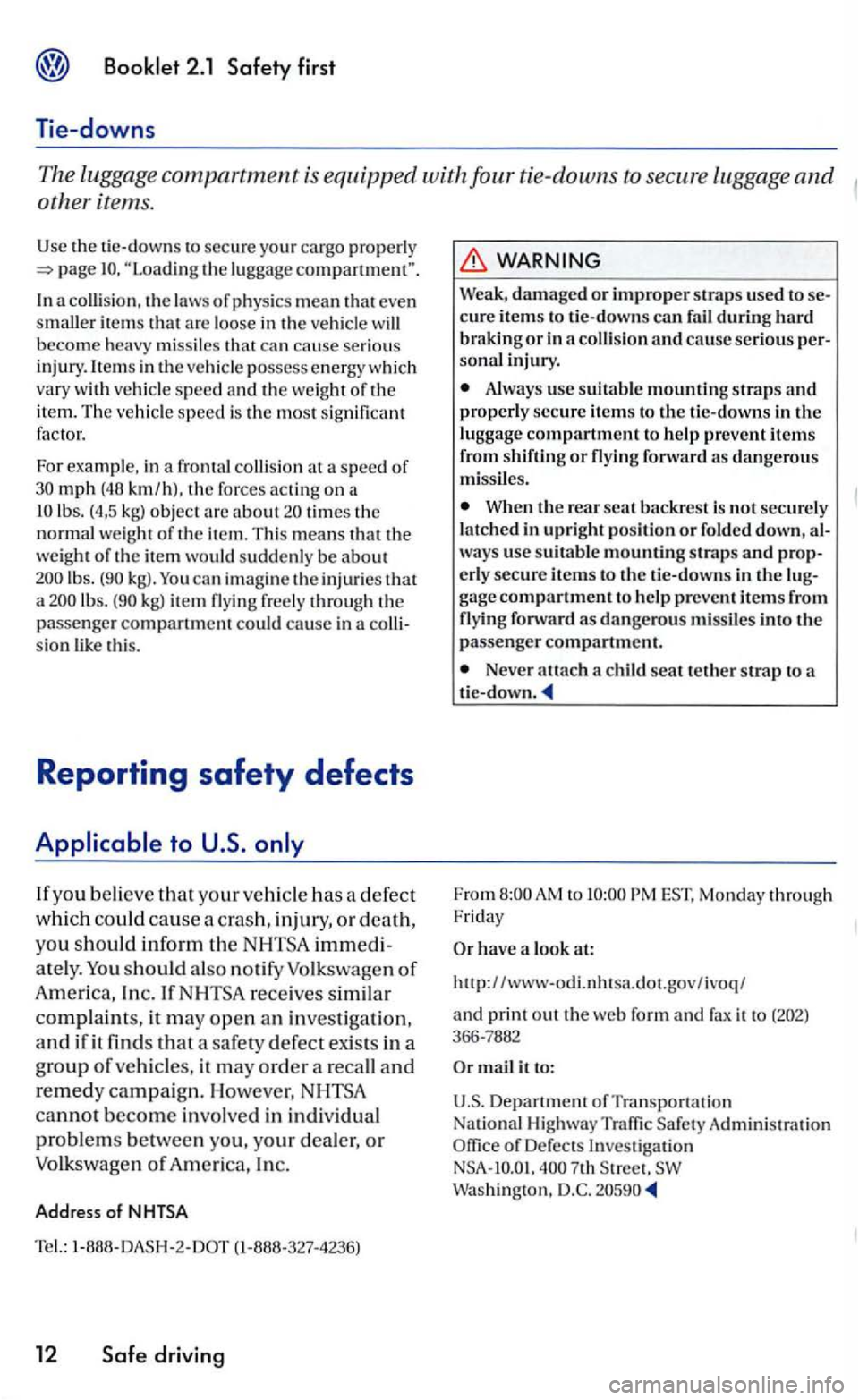
2.1 Saf ety fir s t
Tie-downs
The luggag e c
ompartment is equipped with four tie-downs to secu re luggage and
other it ems.
Use th e tie-downs to secu re you r cargo properly "Loa ding the lu ggage com part mem ".
a collisio n, th e law s of phy sics mean that even
s m aller items that are loose in the vehicle will become heavy missiles that ca n ca use serio us
i njury. h em s in the vehicle possess energ y which vary with vehicle speed and the we ight of the item . T he vehicle sp eed is th e mo st sig nifi cant factor.
For example, in a fronta l
collision at a speed of km /h), the forces acting on a times th e
n ormal weight of the item . Thi s means that the weigh t o f the it em wo uld suddenly be about lbs. kg). You can imagine the inj uries that lbs. kg) item f r ee ly through the passenger compartmem could cause in a
If yo u believe that your ve hicl e has a defec t
w hi
ch co uld ca use a c rash, injury, or death,
yo u sh ould inform the
ate ly. should also notify Volk swage n of
America, Inc. If receives similar
complaints, it may open an inves tigation ,
and if it finds that a safety defect exis ts in a
group of vehi cles, it may order a recall and
remedy campaign . H ow ever,
(1-888-327-42 36)
12 Safe driving
WARN ING
Weak, dam age d or improper strap s used to c ure item s to tie -downs can fail during hard or in a collision and cause serious sonal injury.
Alw ays use suitabl e mounting straps and properly secure item s to th e tic -downs in the luggage compartment to help prevent items from shifting or flying forward as dangerous
m issiles .
When th e re ar scat backre st is n o t securely
latched in upright posit ion or fo ld ed down,
erly secure items to the tie-downs in the g age compartment to help prevent items from
flyin g fonvard as dangerous missiles into the passenger compartment.
Never attach a child seat t eth er strap to a
From to Mo nday throug h
Frid ay
have a look at:
http://www-odi. nhtsa.dot.gov/ivoq/
and print out the web form and fax it to
m ail it to:
U
.S. Departmem of Tra nspo rtatio n Nationa l Highwa y
7th Wash ington,
Page 101 of 444
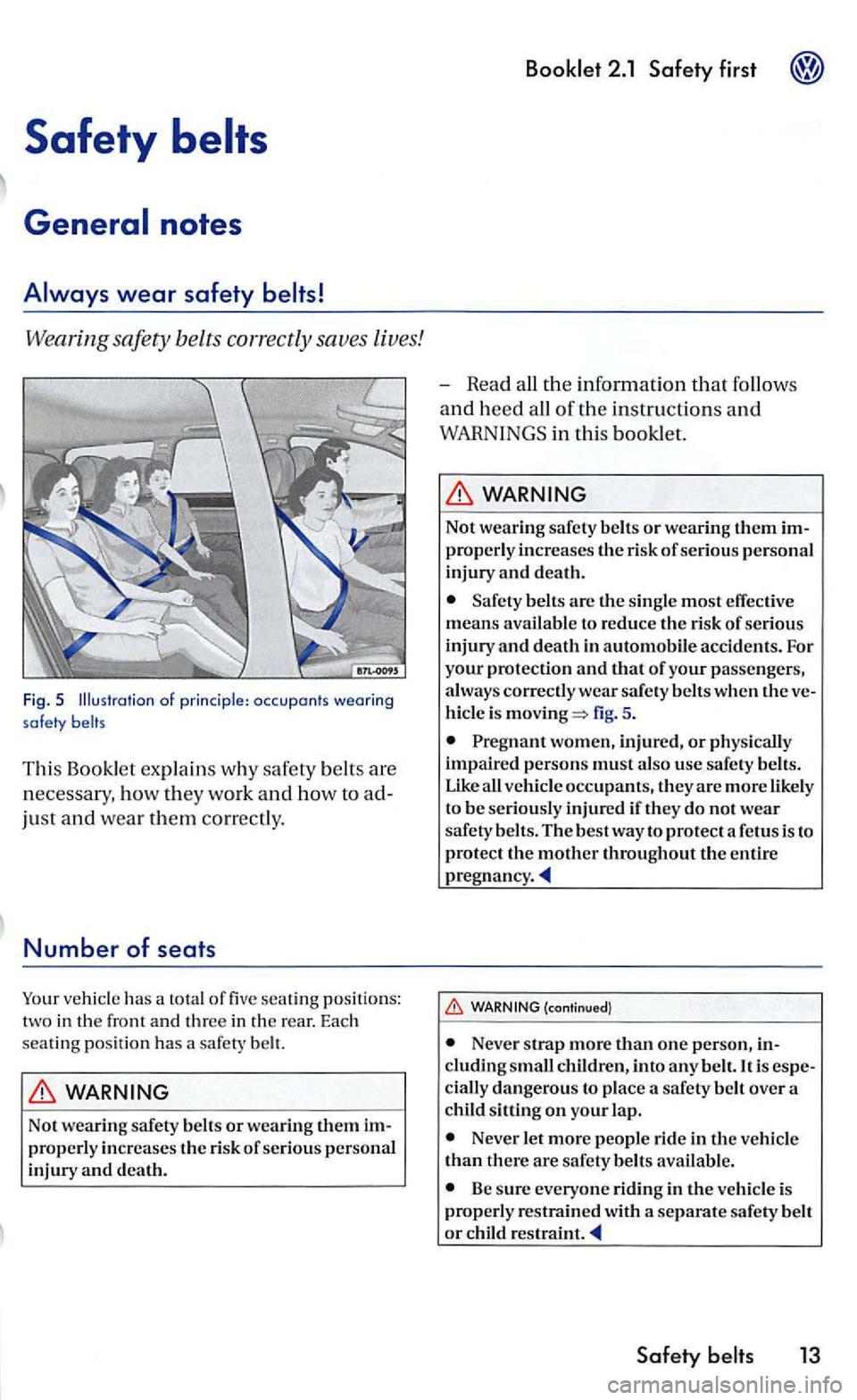
Safety
wear safety
Wearing safety belts correctly saves lives!
Fig. 5 of principle: occu pants wearing safety belts
This Booklet expla in s w hy safety belt s are
necessa ry . how they work and how to
just and wear them correctly .
Number of seats
Your vehicl e has a total of five se ating position s:
two in t h e fron t and three in th e re ar. Eac h seating positio n has a sa fe ty belt.
WARNING
Not wearin g safety belts or wea ring them
- Read all the information that follows
and heed all of the instructio ns and
WARNINGS in thi s bookl et.
WARNING
No t wearing safety belt s o r wearing them properly increases the ris k of se rious pe rson al
injury and death.
Safety belts are th e s ingle most effective
means availa ble to reduce the risk of serious inju ry and death in automobile acciden ts . For your protection and that of your passengers,
a lways correctl y wear safety belts when the hicle is fig. 5 .
Pregnant women, injured, or physically
i mpaired person s must also use safety belts.
Like vehicl e occ upants, th ey are more like ly
to be se riously injured if th ey do not wear safety belts. The best way to protect a fetus is to protec t the mother throughout the entire
pregnancy
(continued !
Never strap more than one person, cluding cially dangerous to plac e a safety belt over a child sittin g on your lap.
Neve r let more people ride in the ve hicle than there are safety belts available.
B e sure everyo ne ridin g in the vehicl e is properl y res trained with a separate sa fety belt
o r chil d res train t
Safety
Page 102 of 444
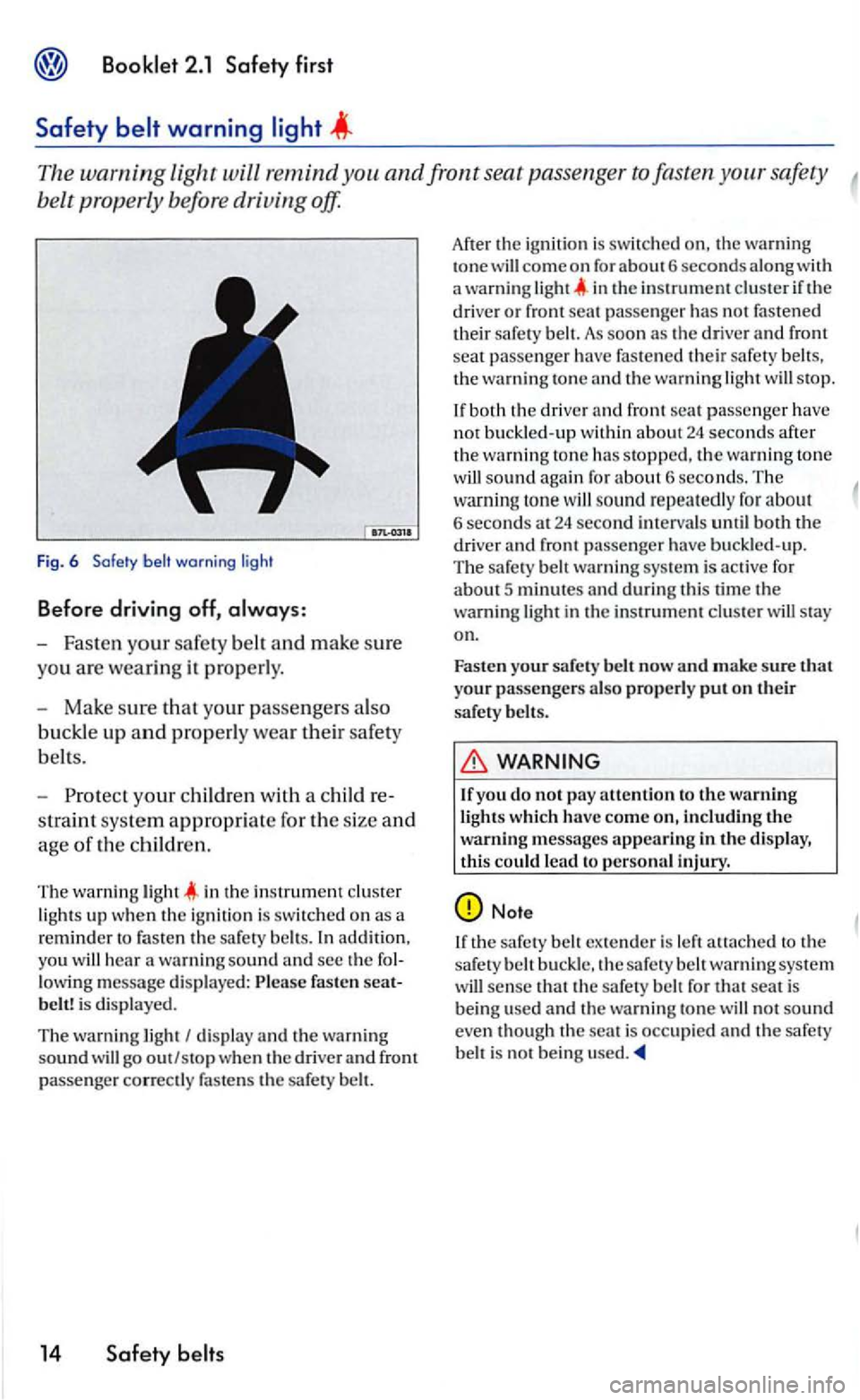
The warning Light will remind safety
belt prop erly before driving off.
Fig . 6 Safety warn in g l ig ht
Before driving off,
-Fast en your safety belt and make sure
you are wea ring it properly.
- Mak e sure that your passengers als o
buckle
up and properly wear their safety
b elts.
- Pro tec t yo
ur children with a child re
s traint sys
tem appropria te for the size and
age of th e children.
T he wa rnin g in the in strument lights up w he n the ig niti on is switched o n as a
reminder to fasten th e safety addition,
yo u
14 Safety
Afte r the ig nition is swit ch ed th e warning tone come on for about6 second s along with warning light in the in strument if th e drive r or front seat passe nge r has not fastened their safet y bel t. As soon as the driver and front seat passe nger have fastened their safety the wa rnin g ton e and the warning light stop .
sound aga in for about 6 second s. The
ton e w ill sound repeatedly for about 6 seconds 24 second interva ls until both drive r and front passenger have buckled-up .
T he safety wa rnin g system is active for about 5 minutes and during thi s time the warni ng light in the instrument clus te r wiU stay
on.
Fa s
ten your safe ty belt now and make sure t hat your passengers also properly put o n their
safery belts.
WARNING
If yo u do not pay attenti on to the warning
li ghts whic h h ave come including the warning messages appearing in the display, this could lead to pe rsonal injury.
ex tender is left attac h ed to the
s afery warning sys tem will sense th at th e safe ty n o t sound even though th e is occ upie d and the safery
Page 106 of 444
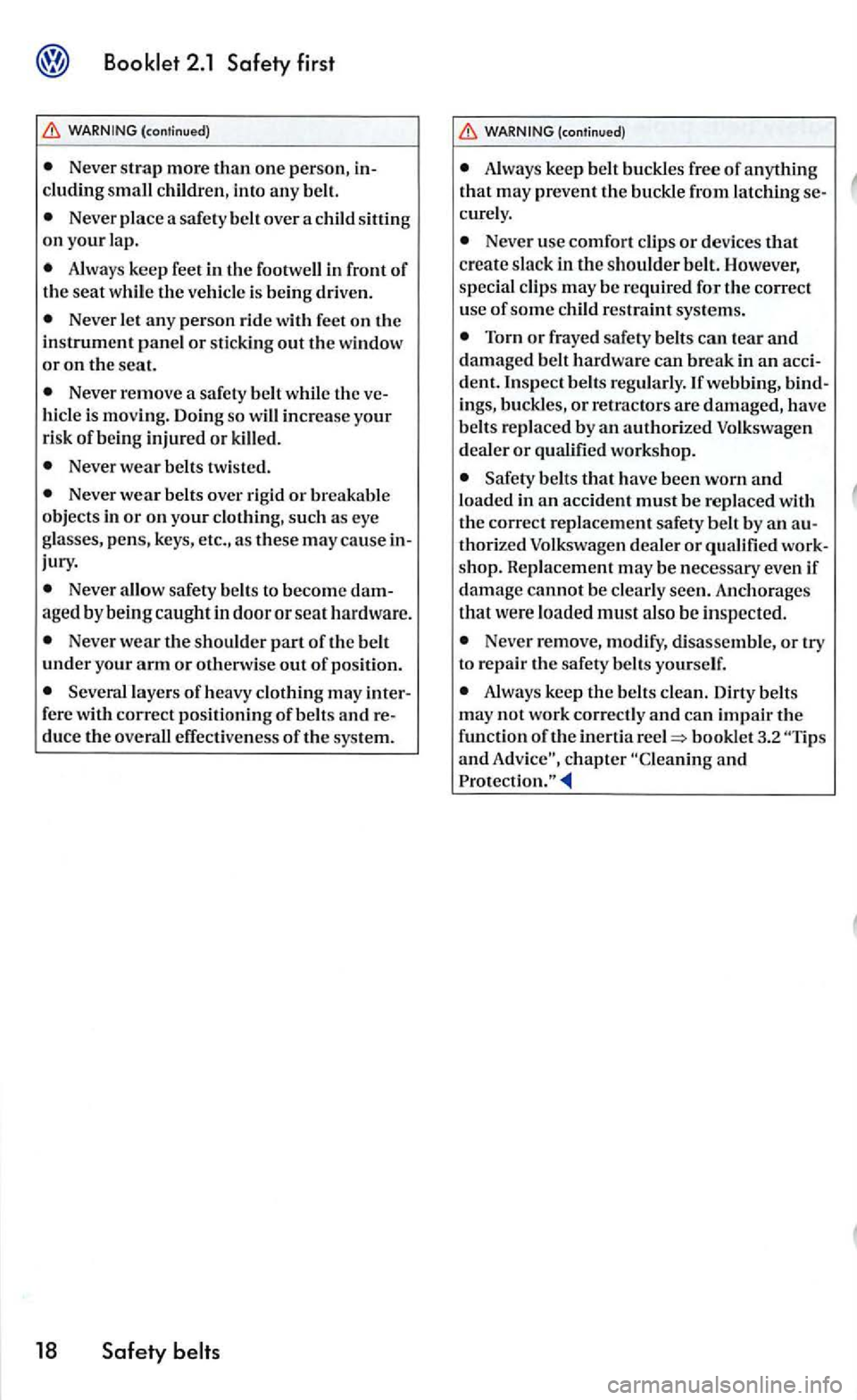
2.1 Safety first
Never strap more than one person, in
cluding c hildren, into any belt.
Never place a safety belt over a child sittin g on your lap.
• Always keep feet in
the footwell in front of the seat while the vehicle is being driven.
Never let any person ride with feet on the instrument panel or sticking out the window or on the seat.
Never remove a safety belt while the ve
hicle is moving. Doing so will increase your
risk of being injured or killed.
Never wear belt s twisted.
Never wear belt s over rigid or breakable
objects in or on your clothing, such as eye
glasses, pens, keys, etc., as these may cause injury.
Never allow safety belts to become damaged by being caught in door or seat hardware.
Never wear the shoulder part of the belt under your arm or othenvise out of position.
Several layers of heavy clothing may inter
fere with correc t positioni11g of belts and reduce the overall effectiveness of the sys tem.
18 Safety
(continu ed)
Always keep belt buckles free of anything
that may preven t the buckle from latch ing se
cure ly.
Neve r use comfort clips or devices that create slack in the sh oulder belt. However,
specia l clips may be required for the correct
use of some c hild restraint systems.
Torn or frayed safety belts can tear and damaged belt hardware can break in an accident.lnspect belts regularly. If webbing, bind
ings, buckles, or retractors are damaged, have
be lts replaced by an authorized Volkswagen
dealer or qualified workshop.
Safety belts that have been worn and loaded in an accident must be replaced with the correc t rep lacement safety belt by an authorized Volkswagen dealer or qualified work
s h op. Replacement may be necessary even if damage cannot be clearly seen. Anchorag es
that were loaded must a lso be inspected.
Never remove, modify, disassem ble, or try
to repair the safety belts yourself.
Alwa ys keep the belts clean. Dirty belts
may not work correct ly and can impair t11e func tion of inertia reel booklet 3.2 and
Page 107 of 444
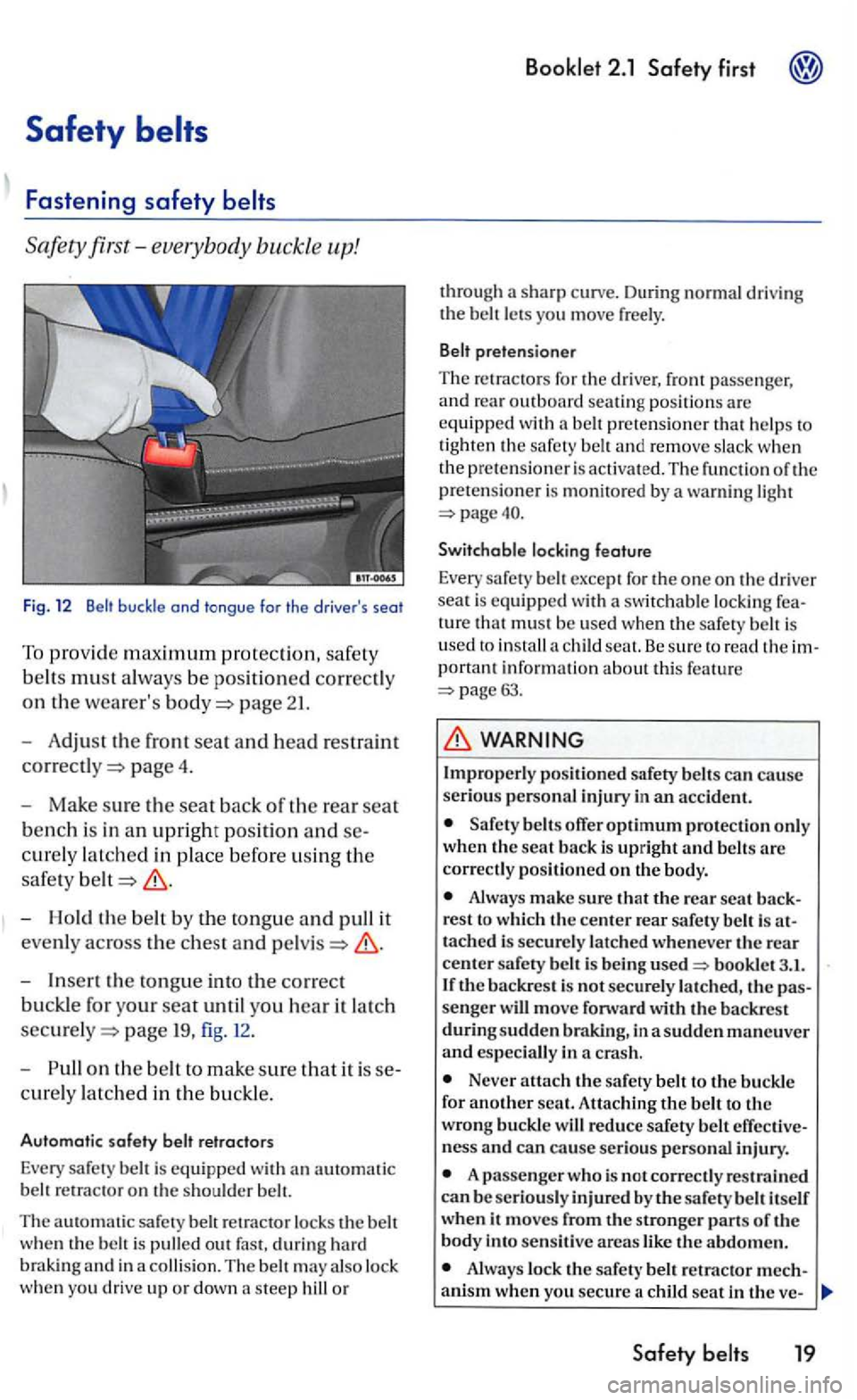
Safety
Safety first-everybody buckle up!
Fig. 12
page 2 1.
- A
djus t the front seat and head restra int
page 4.
-
Make sure the seat back of the rear seat
bench is in an upright position and
cure ly latched in place before using the
safe ty
belt
- Hold the belt b y the to ngue and pull it
eve
nly across the chest and
page 19, fig . 1 2.
-
o n th e belt to make sure that it is se
c u re ly latched in the buckl e.
Automatic safe ty belt retractors
Every safe ly is equi ppe d an o n he s houlder b ell.
The
s a fe ly belt r etrac tor lock s th e belt
w he n the belt is pulled out fast, durin g ha rd
brak ing and in a collision. The ma y also lock when you drive u p or d own a steep hill or
Booklet 2.1
through a sharp curv e. During normal drivin g
the
for the d river, fron t passenge r,
a nd rear out bo ard seating po sition s are equipped wit h a prete n sioner that h elp s to tig h ten the sa fe ty and remove slack w hen
th e pr ete n sioner is act iva te d. Th e functi on of th e
p retension er is monito re d b y a warning light
Switchable lockin g feature
Every safety exce pt for th e one on th e dri ver seat is equipped w ith a switchabl e lock ing ture that mus t be u se d w hen the sa fety is u se d to install a c hild seal. Be sure to read he portant informa tio n abou t thi s fea tur e page63.
WARNING
Improperly posi tion ed safety
offe r optimum protec tion only when the seat back is upright and belts are correctl y po sition ed on the body.
Alwa ys make sure that the rear seat back
r es t to whi ch th e center rear safety is at
tach ed is secu re ly latched whenever th e re ar
cente r safe ty belt is being used bookl et 3.1. If the bac kres t is not s ecurely la tc hed , the passenger wiU move forward with the backre st durin g sudden braking, in a sudden maneuver
and e specially in a cra sh .
Never att ac h the safet y belt to the buckle
for another scat. Atta chin g the belt to the wrong buckle w ill re du ce safety belt ness and can ca use serious perso nal injury.
A passenger who is not correctl y res tra ined can be se riou sly injured by the sa fety belt itself
w hen it moves from th e stronger parts of the body int o sensit ive areas like the abdomen.
Alwa ys lock th e safe ty belt re tra ctor m echanism when yo u secure a child seat in th e ve-
Safety belts 19
Page 111 of 444
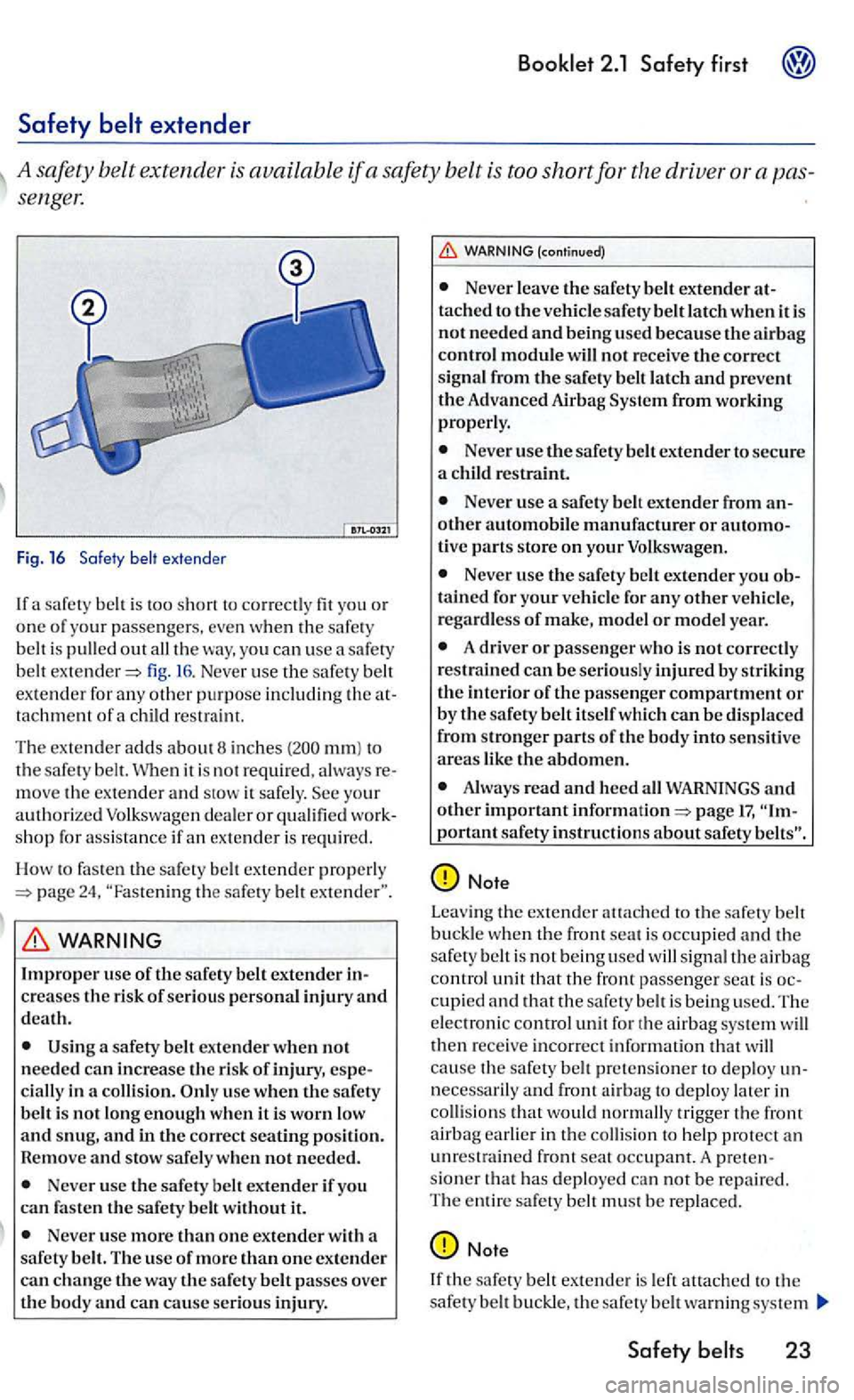
Safety
sengel:
Fig. 16 Safe ty
out fig . 16 . Never use th e safe ty belt
ex tende r for any oth er purpo se includin g th e tachment of a c hild restraint.
Th e
exte nder adds a boutB inches mm) to
the safery belt. Whe n it is not require d , always
s hop for a ss is tan ce if an extende r is requ ired .
H ow to fas te n the s
afety belt extender properly 24, th e sa fe ty belt
crea ses the risk of seriou s personal injury and death.
a safery belt exten de r w hen not needed can increase the risk of injury , cially in a collision. it is worn low
and snug, and in the cor rec t seating position.
R emove and sto w safe ly when not needed.
Never use the safet y belt extender if yo u
ca n fasten the sa fety belt without it.
Never use more than one extender with a
safery be lt. The use of m ore than one extender c a n ch ang e the way the sa fe ty belt passes over
the body and can cause se rious injury .
Never leave the saferybelt extender ta ched to the veh icle safe ty belt latch when it is not needed and being used because th e airbag control module will not re ceive the correc t
s ign al from the safety b elt la tc h and prevent the Advanc ed Airbag from working properly .
Never use the safe ty belt extender to secure
a child restraint.
Never use a safery belt ex tender from
Nev er u se the safery belt extend er yo u tained for your vehicle for any other vehicle,
regardless of make, model or model year.
A driver or pass enger w ho is not correct ly
re strained can be seriously injured b y striki ng the interior of the passe ng er compartment or by the safery b elt its elf whi ch can b e di spla ced
from stronger parts of the body into se nsiti ve areas lik e th e abdomen.
Always read and heed all WARNINGS and other important pa ge
signal th e airbag
co ntrol unit that the front passenge r seat is
ca use the s afery belt prete nsio n er to deploy necessarily and fron t to deplo y la ter in
collision s th at would trigge r the front
a irb ag earlie r in th e to help pro tect an unrestrain ed front seat occ upant. A sioner that has dep loyed can not b e repair ed.
T he entire sa fety belt mu st b e rep laced.
Safety
Page 116 of 444
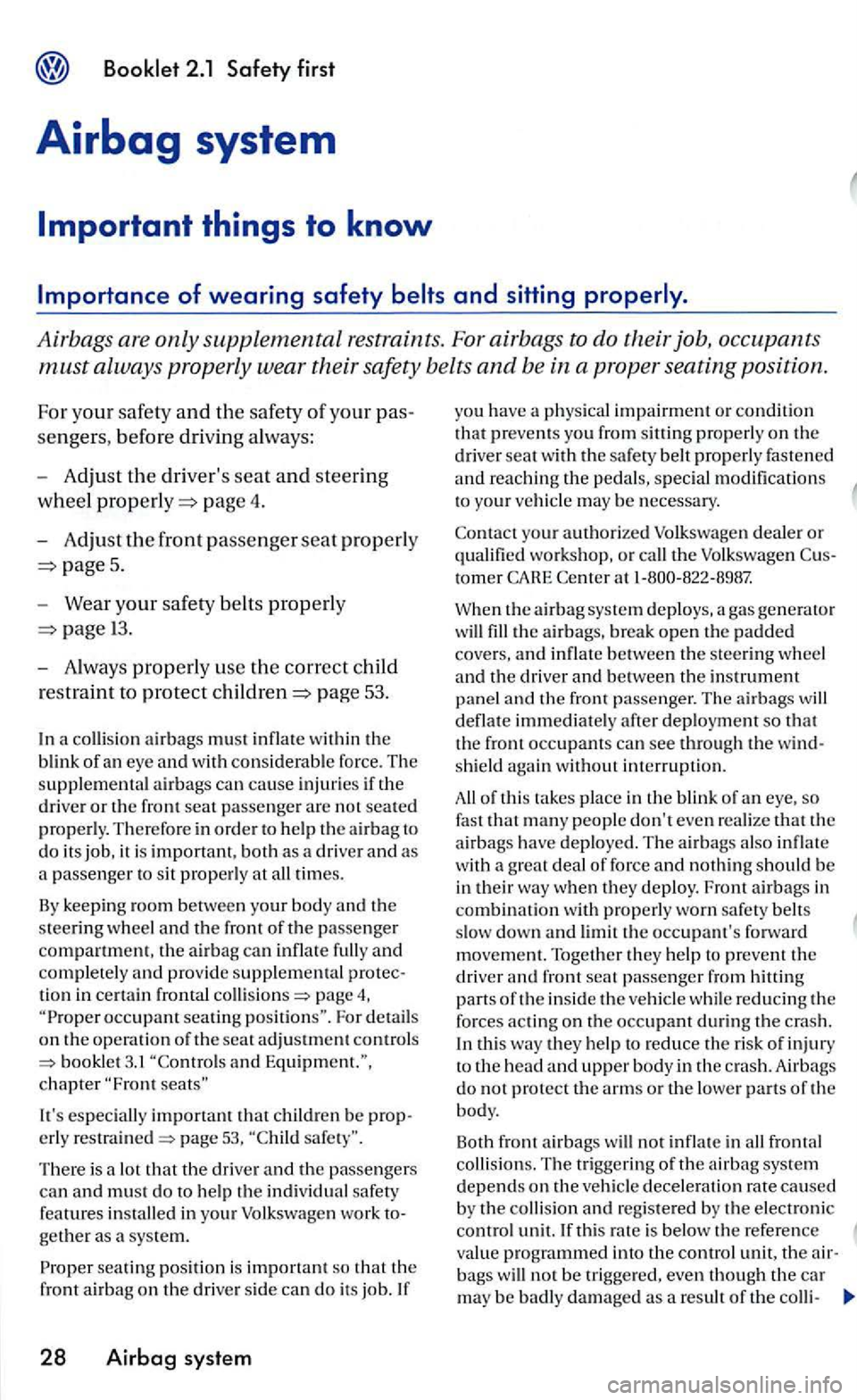
2.1 Safety first
Airbag system
Important things to know
Airbags are only supplemental re straint s. For airbags to do their job,
sen gers, befor e dri vin g a lw ay s:
- Adju st th e driver' s
seat and steering
w heel
5.
- Wear y
our safety be lt s properly
13.
- Always properly use the correct child
re straint
to protect page 53.
a co llisio n airbags mu st
times.
keep in g roo m be tween your bo d y and the
s teerin g w heel and the front of the passe nge r the ai rb ag can and completely and pro vid e supplemental page 4, occupant seatin g For details on th e o perati on of the seat adju stment control s and
important th at page 53,
There is a tha t the dri ver and th e passengers can and must d o t o h elp the individual safe ty feature s work
seating position is important so that the fron t airb ag on the drive r sid e c an do its job.
28 Airbag system
you h ave a physical impairment o r condition that prevents you from sitti ng properly on the
driver seat w ith the safe ty
may be necessary .
your au th o rize d dealer or qualified workshop, or the to mer
When the ai rbag syste m deploys, a gas generato r the ai rbags. brea k ope n the padded cove rs, and
shie ld again without interruptio n.
o f thi s tak es place in the of a n eye, so fast th at many people don 'teven realize that the airbags ha ve deplo yed. The airb ags also
reducing th e forces actin g o n the occupant d ur in g t he crash . th is way th ey help to re duce the ris k of in ju ry
t o the head and uppe r bo dy in t he cra s h. Airbags
d o not protect the arms or the lowe r parts of th e
body.
Both f ront a irb ags no t fro nta l
collisio ns. The tr igger ing o f the airbag sys te m
d epend s o n the an d re gis te re d by the electronic
contro l unit.
b ags